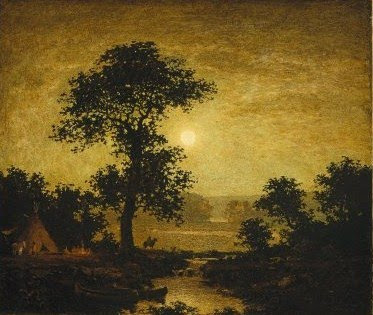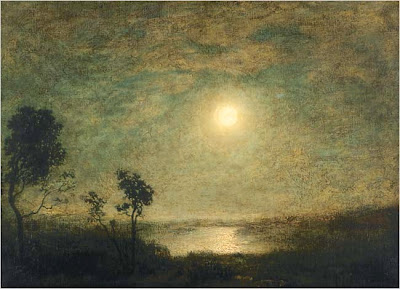I guess we can look at a few more landscapes, some of you might be bored with my affinity for portraits. Another American Tonalist painter was self-taught landscape painter Ralph Albert Blakelock (1847-1919), whose madness kept him in & out of asylums. (Blakelock is a key figure in the setting of Paul Auster's novel Moon Palace.)
![]() Ralph Albert Blakelock (1847-1119) Moonlight. 1885 The Brooklyn Museum.
Ralph Albert Blakelock (1847-1119) Moonlight. 1885 The Brooklyn Museum.
A problem with his work is its uneven quality. He ramped up production when he needed to cover the costs of his rapidly expanding family of 9 children. After his death, Blakelock’s estranged wife wrote to a dealer, “His best work took a long time to complete and in the meantime we had to live.”
![]() Ralph Albert Blakelock (1847-1919) Moonlight Landscape. Corcoran Gallery of Art, Washington DC
Ralph Albert Blakelock (1847-1919) Moonlight Landscape. Corcoran Gallery of Art, Washington DC
When he wasn’t taking shortcuts, Blakelock produced landscapes like his “moonlight” series in which the lunar glow has a diffuse quality. His methods foreshadow modernism as in his liberal use of the palette knife with which built up & scraped away layers to create texture.
![]() Ralph Albert Blakelock (1847-1919) Moonlight Sonata. 1889-92. Museum of Fine Arts, Boston
Ralph Albert Blakelock (1847-1919) Moonlight Sonata. 1889-92. Museum of Fine Arts, Boston
One of his many moonlight paintings was sold to the Corcoran at the highest price ever paid for the work of a living American artist at that time. By the way, that Corcoran painting is my favorite. But his rise in public aclaim along with the increase in his art sales never benefited him or his struggling family. By 1903, his works were being widely forged.
.
+Moonlight.+1885+The+Brooklyn+Museum..jpg) Ralph Albert Blakelock (1847-1119) Moonlight. 1885 The Brooklyn Museum.
Ralph Albert Blakelock (1847-1119) Moonlight. 1885 The Brooklyn Museum.A problem with his work is its uneven quality. He ramped up production when he needed to cover the costs of his rapidly expanding family of 9 children. After his death, Blakelock’s estranged wife wrote to a dealer, “His best work took a long time to complete and in the meantime we had to live.”
++Moonlight+Landscape.+Corcoran+Gallery+of+Art,+Washington+DC.jpg) Ralph Albert Blakelock (1847-1919) Moonlight Landscape. Corcoran Gallery of Art, Washington DC
Ralph Albert Blakelock (1847-1919) Moonlight Landscape. Corcoran Gallery of Art, Washington DCWhen he wasn’t taking shortcuts, Blakelock produced landscapes like his “moonlight” series in which the lunar glow has a diffuse quality. His methods foreshadow modernism as in his liberal use of the palette knife with which built up & scraped away layers to create texture.
+Moonlight+Sonata.+1889-92.+Museum+of+Fine+Arts,+Boston.jpg) Ralph Albert Blakelock (1847-1919) Moonlight Sonata. 1889-92. Museum of Fine Arts, Boston
Ralph Albert Blakelock (1847-1919) Moonlight Sonata. 1889-92. Museum of Fine Arts, BostonOne of his many moonlight paintings was sold to the Corcoran at the highest price ever paid for the work of a living American artist at that time. By the way, that Corcoran painting is my favorite. But his rise in public aclaim along with the increase in his art sales never benefited him or his struggling family. By 1903, his works were being widely forged.
.